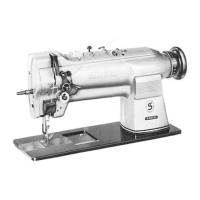I LOWER TIMING
,1
MARK
BOBBIN
CASE
STOP
FINGER
Fig. 27. Sewing Hook Height Adjustment (Step One)
HOOK
GIB
NEEDLE
GUARD
HOOK
HEIGHT
ADJUSTING
SCREW
HOOK
HUB
SOCKET
SCREWS
Fig.
28. Sewing Hook Height Adjustment (Step Two)
HOOK
DRIVING
GEARS
HOOK
SADDLE
SCREWS
Fig.
29. Sewing Hook Adjustments
ADJUSTMENT
OF
SEWING
HOOK
HEIGHT
When
lower timing mark on needle bar is just
visible
at lower end of needle bar frame on upword
stroke of needle, the
hook
should pass about 1/16
inch above upper edge of needle eye as shown in
Fig.
27.
To adiust height of sewing hook, first fasten
throat plate to bed of machine and place bobbin
case
stop finger in sewing position.
Pass
a .032 inch shim
between bobbin case stop finger and throat plate. If
shim is too tight or too loose, turn machine pulley
over toward you so that the hook hub socket screws
shown
in Fig. 28 are accessible with a socket
wrench.
Loosen
both
screws
and
remove
cloth
washer
from
bobbin
case.
Turn
bobbin
case
until
one
of
the
holes
is in line with hook height adjusting screw. To
raise
hook, turn hook height adjusting screw downward. To
lower hook, turn hook height adjusting screw up. Re-
tighten socket screws and turn hook height adjusting
screw again just enough to leave a light tension.
Check sewing hook timing.
ADJUSTMENT
OF
DISTANCE
BETWEEN
SEWING
HOOK
AND
NEEDLE
To prevent hook point
from
dividing strands of
thread, it should
pass
as
near to the
needle
as
pos
sible
without hitting it.
Turn machine pulley over toward you until sewing
hook
point
is in
the
position
nearest
to
needle.
Tip
machine
and
loosen
hook
saddle
screws
shown
in
Fig. 29. Adjust hook saddle until hook point is as
close
to
needle
as
possible
without
hitting
it. Re-
tighten hook
saddle
screws BE SURE
HOOK
DRIVING
GEARS
SHOWN
IN
FIG.
29
ARE
CORRECTLY
SET
WITH
RELATION
TO
FACE
OF
HOOK
SADDLE.
USE
.008
INCH
SHIM.
The
function of the
needle
guard shown in
Fig.
28
is to prevent hook point from striking
needle,
if
needle
is
deflected
after penetrating material. The needle
guard
can be bent with a pair of
pliers,
if
necessary,
but
care
should be
taken
to prevent guard from inter
fering with normal path of
needle.

